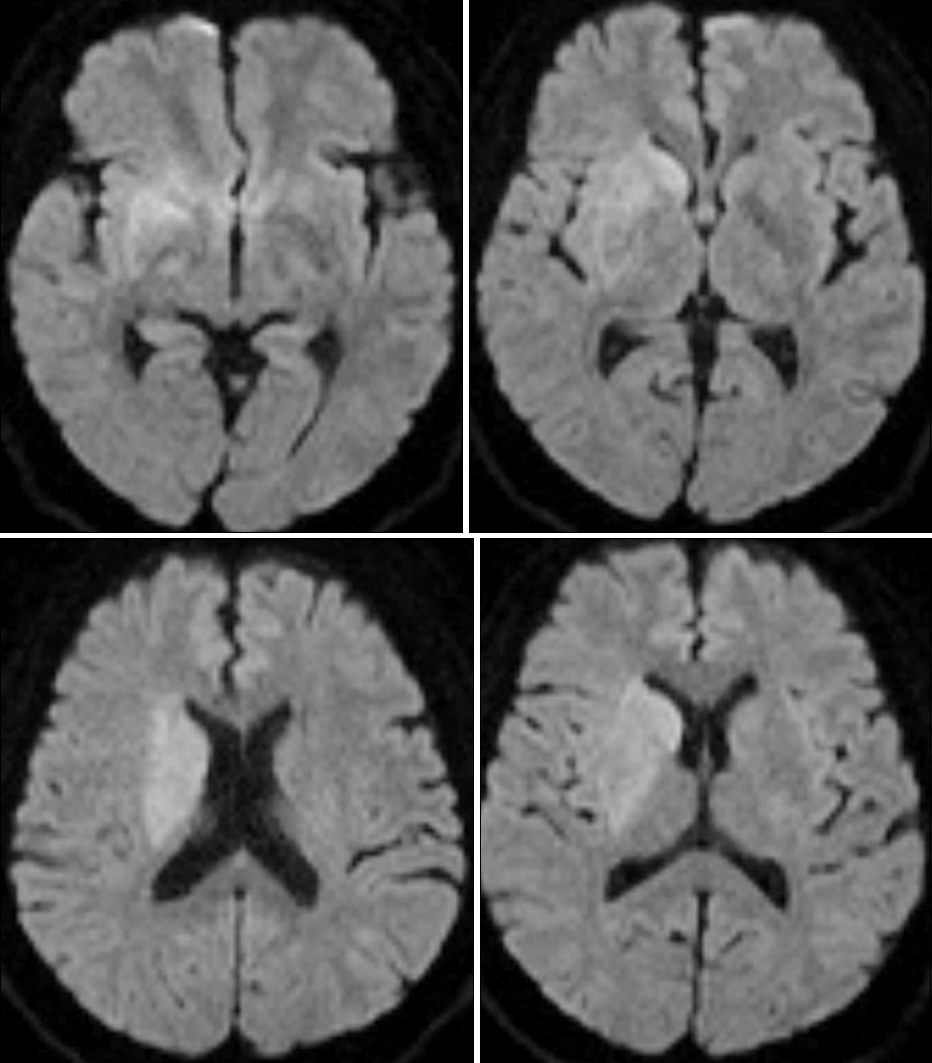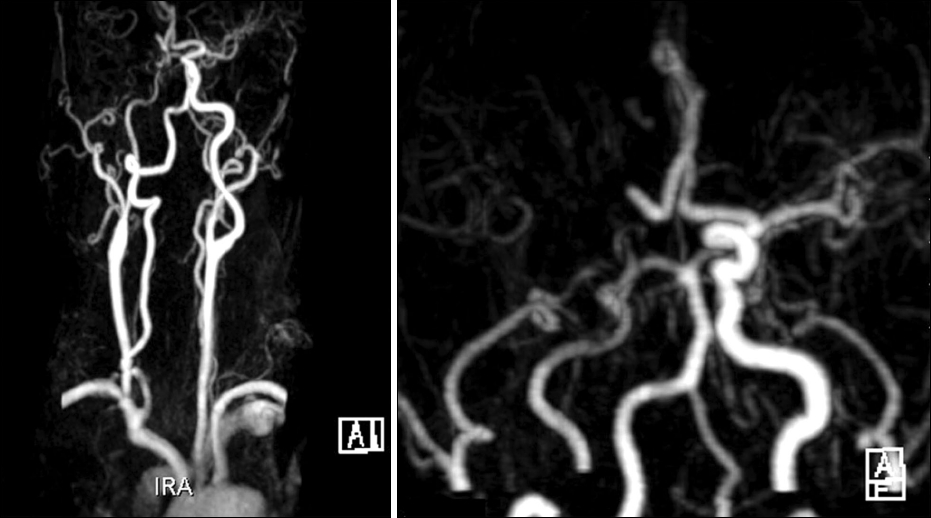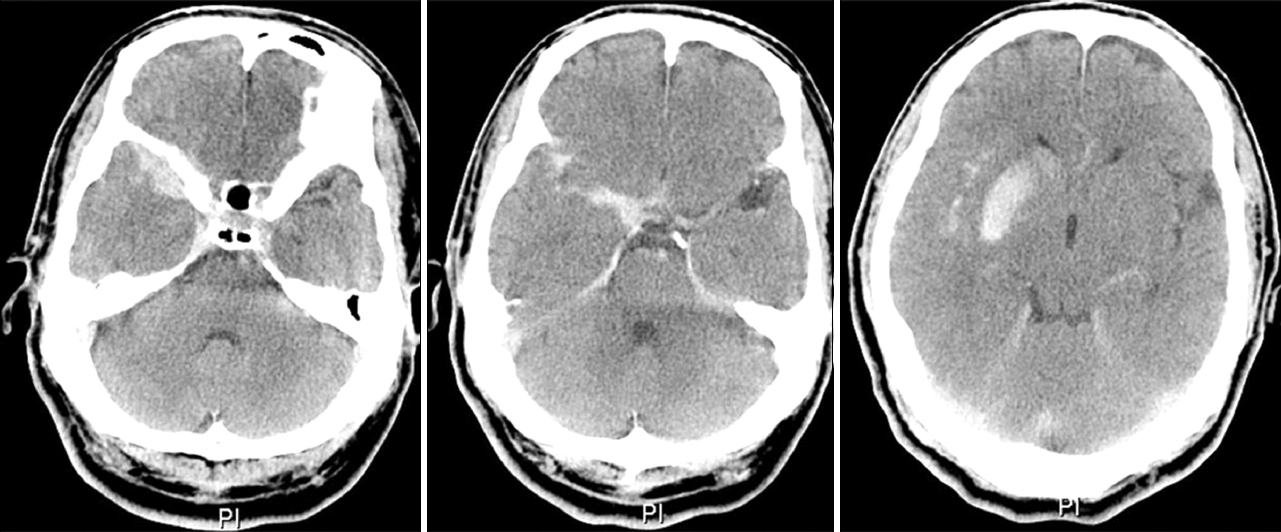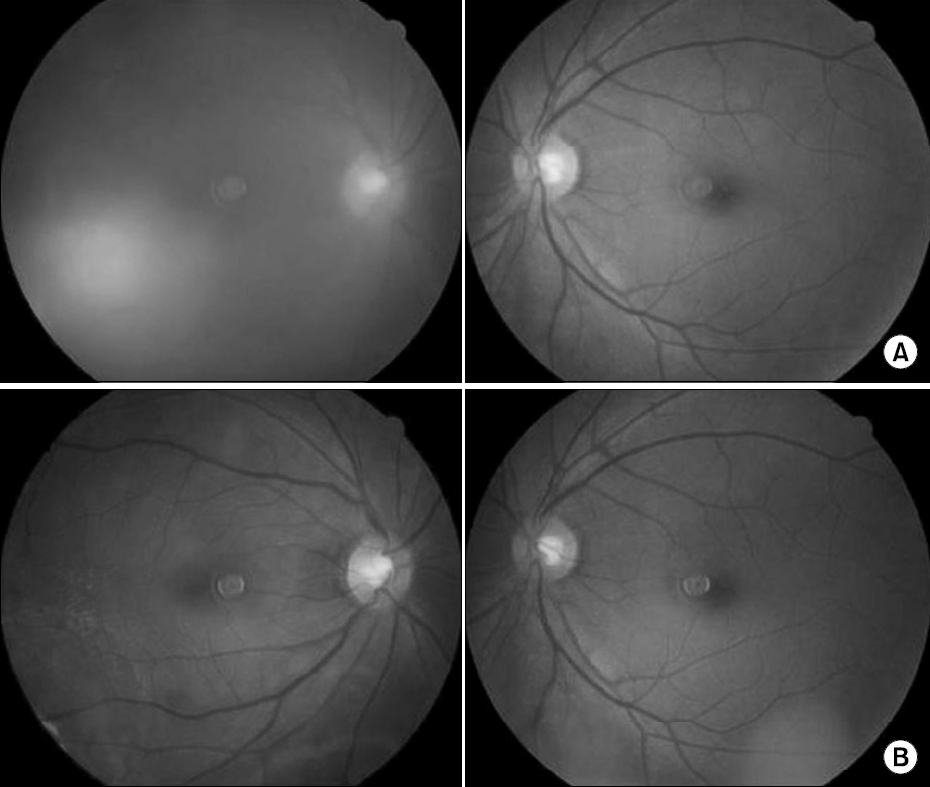Brain Neurorehabil.
2014 Sep;7(2):136-142. 10.12786/bn.2014.7.2.136.
Terson Syndrome after Subarachnoid Hemorrhage Occurred by Thrombolysis and Mechanical Thrombectomy to Treat Acute Ischemic Stroke: A Case Report
- Affiliations
-
- 1Department of Rehabilitation Medicine, Gyeongsang National University Graduate School of Medicine, Korea. rmeslee@gnu.ac.kr
- KMID: 1797648
- DOI: http://doi.org/10.12786/bn.2014.7.2.136
Abstract
- Terson syndrome is a vitreous hemorrhage associated with subarachnoid hemorrhage. This can be caused by spontaneous, aneurysmal rupture or traumatic subarachnoid hemorrhage, but never has been reported as a consequence of hemorrhage due to thrombolysis and thrombectomy treatments of acute ischemic stroke patient. A 48-year-old man presented with left sided weakness was diagnosed as cerebral infarction on right middle cerebral artery territory due to complete occlusion of right distal internal carotid, middle cerebral, and anterior cerebral artery. He underwent thrombolysis and mechanical thrombectomy, and subarachnoid hemorrhage developed. Later, visual disturbance on right eye occurred so he was consulted to ophthalmology. Vitreous hemorrhage was found and surgery was recommended after two weeks of observation. After pars planar vitrectomy, visual acuity improved, along with functional ability. Therefore, possibilities of Terson syndrome in patients with subarachnoid hemorrhage have to be kept in mind to improve not only visual acuity but also rehabilitation outcome.
Keyword
MeSH Terms
Figure
Reference
-
1. Terson A. De l’hémorrhagie dans le corps vitre au cours de l'hémorrhagie cerebrale. Clin Ophthalmol. 1990; 6:309–312.2. Sakamoto M, Nakamura K, Shibata M, Yokoyama K, Matsuki M, Ikeda T. Magnetic resonance imaging findings of Terson’s syndrome suggesting a possible vitreous hemorrhage mechanism. Jpn J Ophthalmol. 2010; 54:135–139.
Article3. Stienen MN, Lücke S, Gautschi OP, Harders A. Terson haemorrhage in patients suffering aneurysmal subarachnoid haemorrhage: a prospective analysis of 60 consecutive patients. Clin Neurol Neurosurg. 2012; 114:535–538.
Article4. Swallow CE, Tsuruda JS, Digre KB, Glaser MJ, Davidson HC, Harnsberger HR. Terson syndrome: CT evaluation in 12 patients. AJNR Am J Neuroradiol. 1998; 19:743–747.5. Gralla J, Brekenfeld C, Mordasini P, Schroth G. Mechanical Thrombolysis and Stenting in Acute Ischemic Stroke. Stroke. 2012; 43:280–285.
Article6. Rha JH, Saver JL. The impact of recanalization on ischemic stroke outcome: a meta-analysis. Stroke. 2007; 38:967–973.7. Shi ZS, Liebeskind DS, Loh Y, Saver JL, Starkman S, Vespa PM, et al. Predictors of subarachnoid hemorrhage in acute ischemic stroke with endovascular therapy. Stroke. 2010; 41:2775–2781.
Article8. Yoon W, Jung MY, Jung SH, Park MS, Kim JT, Kang HK. Subarachnoid hemorrhage in a multimodal approach heavily weighted toward mechanical thrombectomy with solitaire stent in acute stroke. Stroke. 2013; 44:414–419.
Article9. Superstein R, Gomolin JE, Hammouda W, Rosenberg A, Overbury O, Arsenault C. Prevalence of ocular hemorrhage in patients receiving warfarin therapy. Can J Ophthalmol. 2000; 35:385–389.
Article10. Manschot WA. Subarachnoid hemorrhage: intraocular symptoms and their pathogenesis. Am J Ophthalmol. 1954; 38:501–505.11. Fahmy JA. Fundal haemorrhages in ruptured intracranial aneurysms. II. Correlation with the clinical course. Acta Ophthalmol (Copenh). 1973; 51:299–304.
Article12. McCarron MO, Alberts MJ, McCarron P. A systematic review of Terson\'s syndrome: frequency and prognosis after subarachnoid haemorrhage. J Neurol Neurosurg Psychiatry. 2004; 75:491–493.
Article13. Ogawa T, Kitaoka T, Dake Y, Amemiya T. Terson syndrome: a case report suggesting the mechanism of vitreous hemorrhage. Ophthalmology. 2001; 108:1654–1656.14. Sand KM, Midelfart A, Thomassen L, Melms A, Wilhelm H, Hoff JM. Visual impairment in stroke patients--a review. Acta Neurol Scand Suppl. 2013; 196:52–56.15. Khan S, Leung E, Jay WM. Stroke and visual rehabilitation. Top Stroke Rehabil. 2008; 15:27–36.
Article16. Berry C, Weir C, Hammer H. A case of intraocular haemorrhage secondary to thrombolytic therapy. Acta Ophthalmol Scand. 2002; 80:561–562.
Article17. Chorich L, Derick R, Chambers R, Cahill KV, Quartetti EJ, Fry JA, Bush CA. Hemorrhagic ocular complications associated with the use of systemic thrombolytic agents. Ophthalmology. 1998; 105:428–431.
Article18. Kaba RA, Cox D, Lewis A, Bloom P, Dubrey S. Intraocular haemorrhage after thrombolysis. Lancet. 2005; 365:330.
Article19. Hormese M, Wichter M. Vitreo-retinal hemorrhage after thrombolysis in a patient with acute ischemic stroke: a case report. Front Neurol. 2012; 3:71.
Article
- Full Text Links
- Actions
-
Cited
- CITED
-
- Close
- Share
- Similar articles
-
- Intravenous Thrombolysis and Endovascular Thrombectomy in Acute Ischemic Stroke with Minor Symptom
- Interventional Recanalization Treatment of Acute Ischemic Stroke
- Cell free DNA: A Novel Predictor of Neurological Outcome after Intravenous Thrombolysis and/or Mechanical Thrombectomy in Acute Ischemic Stroke Patients
- Terson Syndrome in Aneurysmal Subarachnoid Hemorrhage: A Case Report
- Intraarterial mechanical thrombectomy for the treatment of postoperative cerebral infarction: a case report






